Human Resource Development Plan for AirAsia, Malaysia
VerifiedAdded on 2023/01/19
|15
|3307
|60
AI Summary
This report provides an explanation of the human resource development program and proposes its evaluation methods for the development of the employees of AirAsia, Malaysia.
Contribute Materials
Your contribution can guide someone’s learning journey. Share your
documents today.
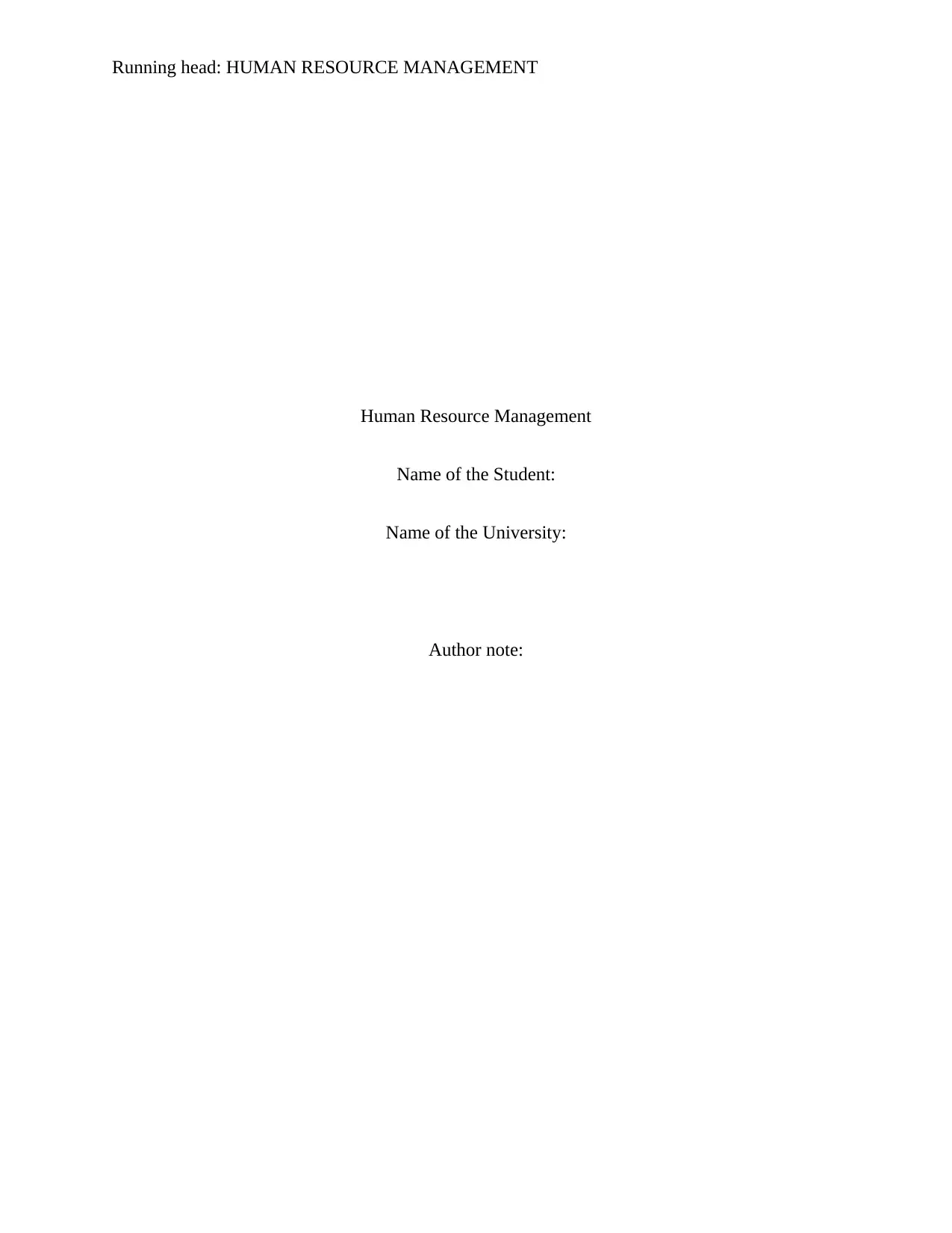
Running head: HUMAN RESOURCE MANAGEMENT
Human Resource Management
Name of the Student:
Name of the University:
Author note:
Human Resource Management
Name of the Student:
Name of the University:
Author note:
Secure Best Marks with AI Grader
Need help grading? Try our AI Grader for instant feedback on your assignments.
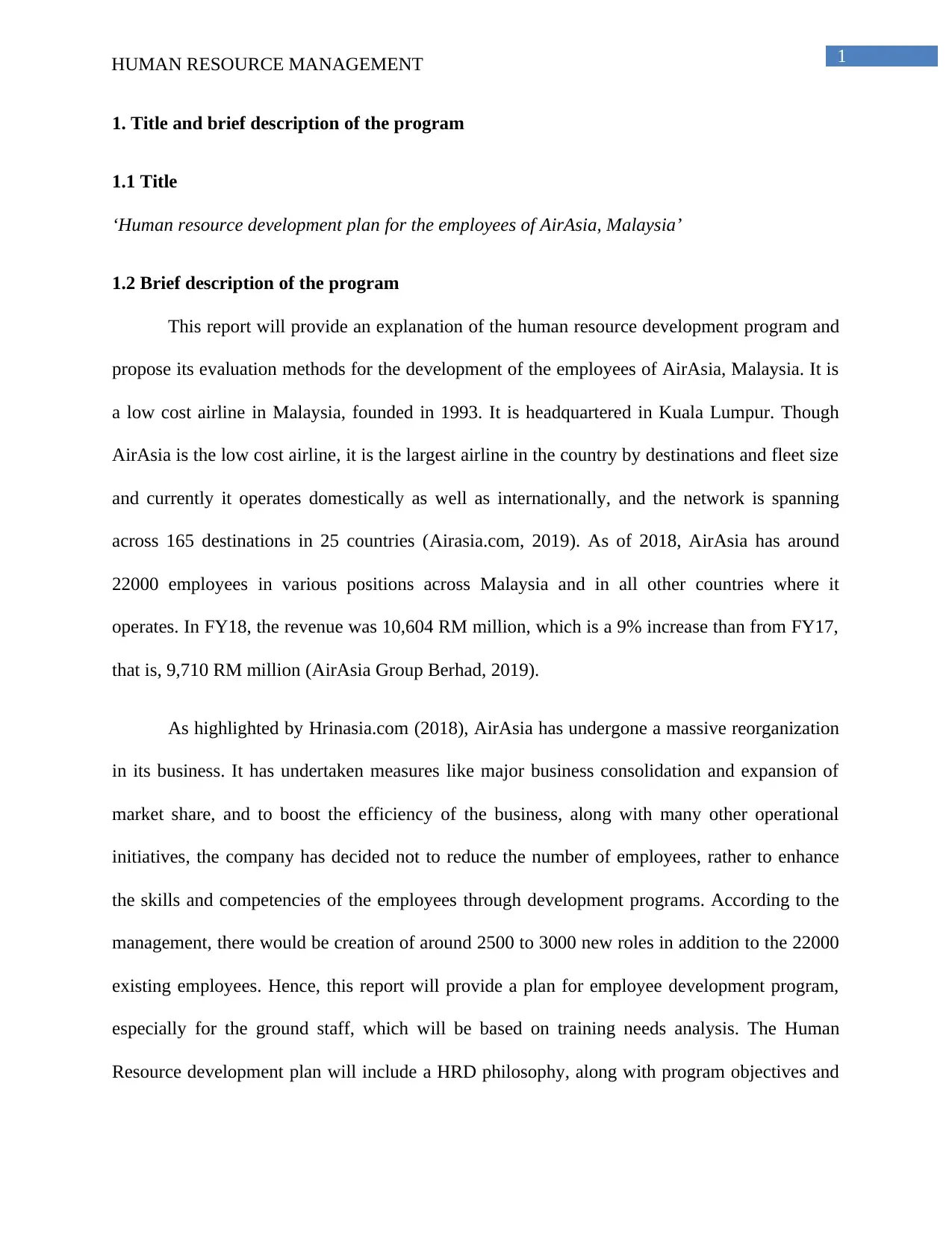
1HUMAN RESOURCE MANAGEMENT
1. Title and brief description of the program
1.1 Title
‘Human resource development plan for the employees of AirAsia, Malaysia’
1.2 Brief description of the program
This report will provide an explanation of the human resource development program and
propose its evaluation methods for the development of the employees of AirAsia, Malaysia. It is
a low cost airline in Malaysia, founded in 1993. It is headquartered in Kuala Lumpur. Though
AirAsia is the low cost airline, it is the largest airline in the country by destinations and fleet size
and currently it operates domestically as well as internationally, and the network is spanning
across 165 destinations in 25 countries (Airasia.com, 2019). As of 2018, AirAsia has around
22000 employees in various positions across Malaysia and in all other countries where it
operates. In FY18, the revenue was 10,604 RM million, which is a 9% increase than from FY17,
that is, 9,710 RM million (AirAsia Group Berhad, 2019).
As highlighted by Hrinasia.com (2018), AirAsia has undergone a massive reorganization
in its business. It has undertaken measures like major business consolidation and expansion of
market share, and to boost the efficiency of the business, along with many other operational
initiatives, the company has decided not to reduce the number of employees, rather to enhance
the skills and competencies of the employees through development programs. According to the
management, there would be creation of around 2500 to 3000 new roles in addition to the 22000
existing employees. Hence, this report will provide a plan for employee development program,
especially for the ground staff, which will be based on training needs analysis. The Human
Resource development plan will include a HRD philosophy, along with program objectives and
1. Title and brief description of the program
1.1 Title
‘Human resource development plan for the employees of AirAsia, Malaysia’
1.2 Brief description of the program
This report will provide an explanation of the human resource development program and
propose its evaluation methods for the development of the employees of AirAsia, Malaysia. It is
a low cost airline in Malaysia, founded in 1993. It is headquartered in Kuala Lumpur. Though
AirAsia is the low cost airline, it is the largest airline in the country by destinations and fleet size
and currently it operates domestically as well as internationally, and the network is spanning
across 165 destinations in 25 countries (Airasia.com, 2019). As of 2018, AirAsia has around
22000 employees in various positions across Malaysia and in all other countries where it
operates. In FY18, the revenue was 10,604 RM million, which is a 9% increase than from FY17,
that is, 9,710 RM million (AirAsia Group Berhad, 2019).
As highlighted by Hrinasia.com (2018), AirAsia has undergone a massive reorganization
in its business. It has undertaken measures like major business consolidation and expansion of
market share, and to boost the efficiency of the business, along with many other operational
initiatives, the company has decided not to reduce the number of employees, rather to enhance
the skills and competencies of the employees through development programs. According to the
management, there would be creation of around 2500 to 3000 new roles in addition to the 22000
existing employees. Hence, this report will provide a plan for employee development program,
especially for the ground staff, which will be based on training needs analysis. The Human
Resource development plan will include a HRD philosophy, along with program objectives and
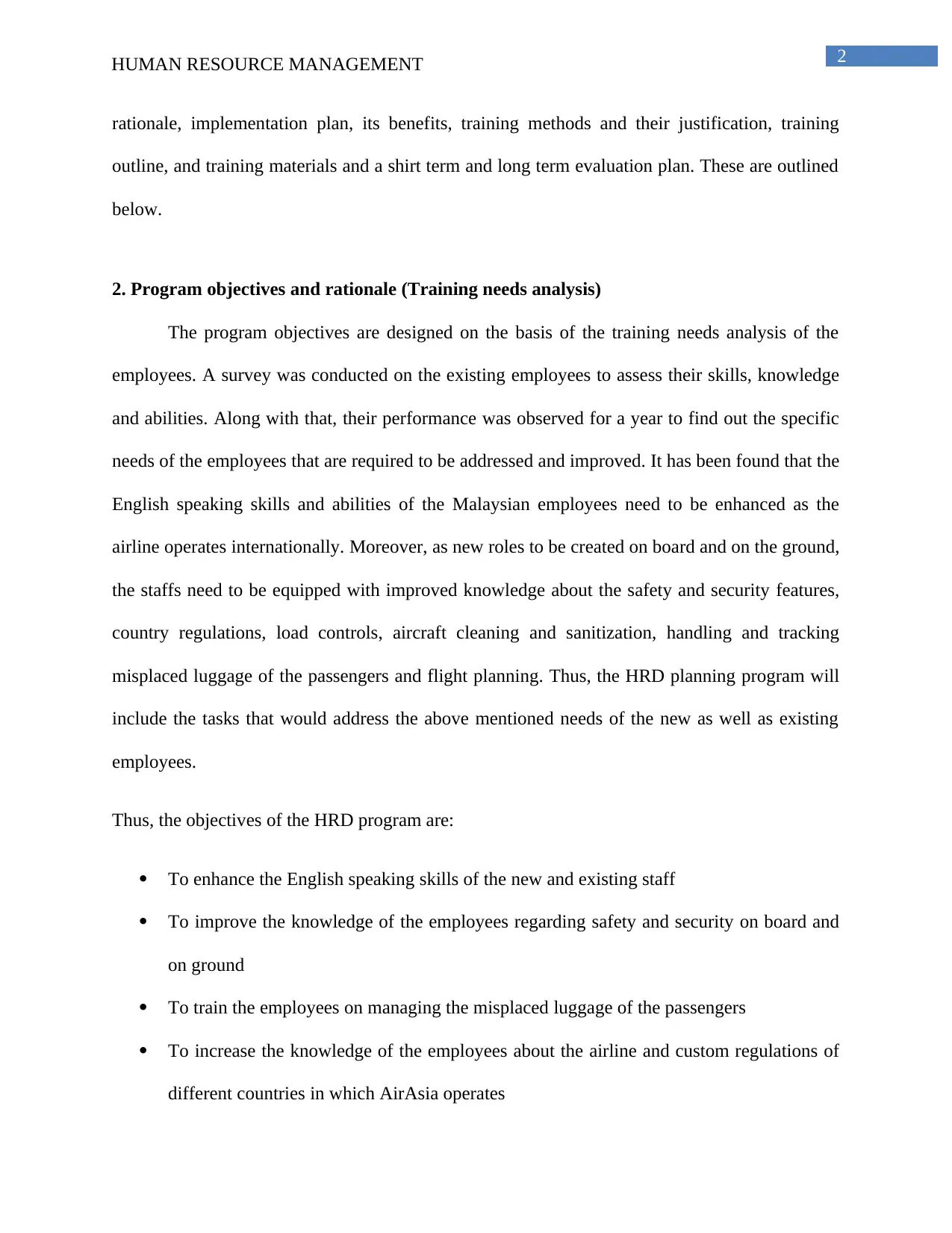
2HUMAN RESOURCE MANAGEMENT
rationale, implementation plan, its benefits, training methods and their justification, training
outline, and training materials and a shirt term and long term evaluation plan. These are outlined
below.
2. Program objectives and rationale (Training needs analysis)
The program objectives are designed on the basis of the training needs analysis of the
employees. A survey was conducted on the existing employees to assess their skills, knowledge
and abilities. Along with that, their performance was observed for a year to find out the specific
needs of the employees that are required to be addressed and improved. It has been found that the
English speaking skills and abilities of the Malaysian employees need to be enhanced as the
airline operates internationally. Moreover, as new roles to be created on board and on the ground,
the staffs need to be equipped with improved knowledge about the safety and security features,
country regulations, load controls, aircraft cleaning and sanitization, handling and tracking
misplaced luggage of the passengers and flight planning. Thus, the HRD planning program will
include the tasks that would address the above mentioned needs of the new as well as existing
employees.
Thus, the objectives of the HRD program are:
To enhance the English speaking skills of the new and existing staff
To improve the knowledge of the employees regarding safety and security on board and
on ground
To train the employees on managing the misplaced luggage of the passengers
To increase the knowledge of the employees about the airline and custom regulations of
different countries in which AirAsia operates
rationale, implementation plan, its benefits, training methods and their justification, training
outline, and training materials and a shirt term and long term evaluation plan. These are outlined
below.
2. Program objectives and rationale (Training needs analysis)
The program objectives are designed on the basis of the training needs analysis of the
employees. A survey was conducted on the existing employees to assess their skills, knowledge
and abilities. Along with that, their performance was observed for a year to find out the specific
needs of the employees that are required to be addressed and improved. It has been found that the
English speaking skills and abilities of the Malaysian employees need to be enhanced as the
airline operates internationally. Moreover, as new roles to be created on board and on the ground,
the staffs need to be equipped with improved knowledge about the safety and security features,
country regulations, load controls, aircraft cleaning and sanitization, handling and tracking
misplaced luggage of the passengers and flight planning. Thus, the HRD planning program will
include the tasks that would address the above mentioned needs of the new as well as existing
employees.
Thus, the objectives of the HRD program are:
To enhance the English speaking skills of the new and existing staff
To improve the knowledge of the employees regarding safety and security on board and
on ground
To train the employees on managing the misplaced luggage of the passengers
To increase the knowledge of the employees about the airline and custom regulations of
different countries in which AirAsia operates
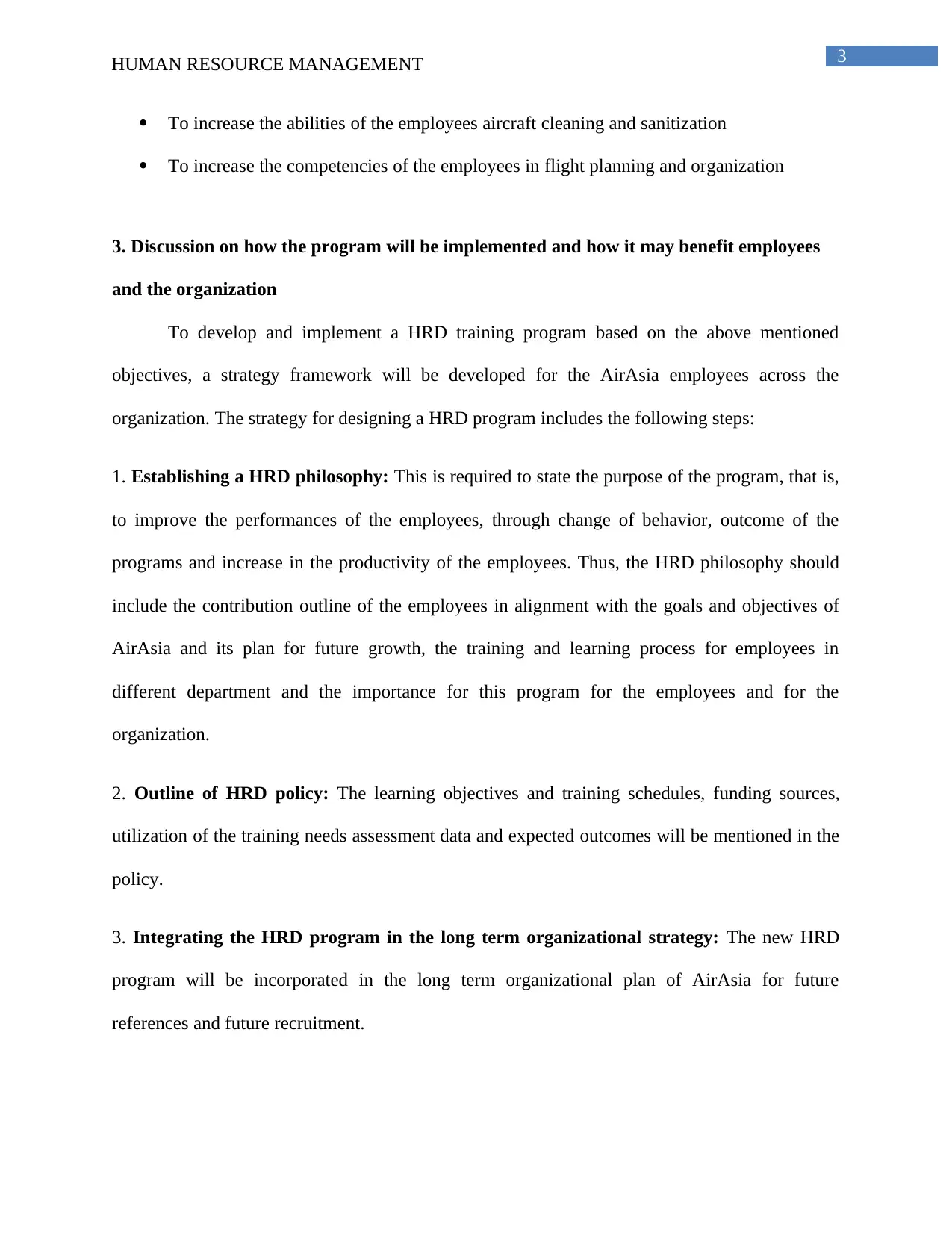
3HUMAN RESOURCE MANAGEMENT
To increase the abilities of the employees aircraft cleaning and sanitization
To increase the competencies of the employees in flight planning and organization
3. Discussion on how the program will be implemented and how it may benefit employees
and the organization
To develop and implement a HRD training program based on the above mentioned
objectives, a strategy framework will be developed for the AirAsia employees across the
organization. The strategy for designing a HRD program includes the following steps:
1. Establishing a HRD philosophy: This is required to state the purpose of the program, that is,
to improve the performances of the employees, through change of behavior, outcome of the
programs and increase in the productivity of the employees. Thus, the HRD philosophy should
include the contribution outline of the employees in alignment with the goals and objectives of
AirAsia and its plan for future growth, the training and learning process for employees in
different department and the importance for this program for the employees and for the
organization.
2. Outline of HRD policy: The learning objectives and training schedules, funding sources,
utilization of the training needs assessment data and expected outcomes will be mentioned in the
policy.
3. Integrating the HRD program in the long term organizational strategy: The new HRD
program will be incorporated in the long term organizational plan of AirAsia for future
references and future recruitment.
To increase the abilities of the employees aircraft cleaning and sanitization
To increase the competencies of the employees in flight planning and organization
3. Discussion on how the program will be implemented and how it may benefit employees
and the organization
To develop and implement a HRD training program based on the above mentioned
objectives, a strategy framework will be developed for the AirAsia employees across the
organization. The strategy for designing a HRD program includes the following steps:
1. Establishing a HRD philosophy: This is required to state the purpose of the program, that is,
to improve the performances of the employees, through change of behavior, outcome of the
programs and increase in the productivity of the employees. Thus, the HRD philosophy should
include the contribution outline of the employees in alignment with the goals and objectives of
AirAsia and its plan for future growth, the training and learning process for employees in
different department and the importance for this program for the employees and for the
organization.
2. Outline of HRD policy: The learning objectives and training schedules, funding sources,
utilization of the training needs assessment data and expected outcomes will be mentioned in the
policy.
3. Integrating the HRD program in the long term organizational strategy: The new HRD
program will be incorporated in the long term organizational plan of AirAsia for future
references and future recruitment.
Secure Best Marks with AI Grader
Need help grading? Try our AI Grader for instant feedback on your assignments.
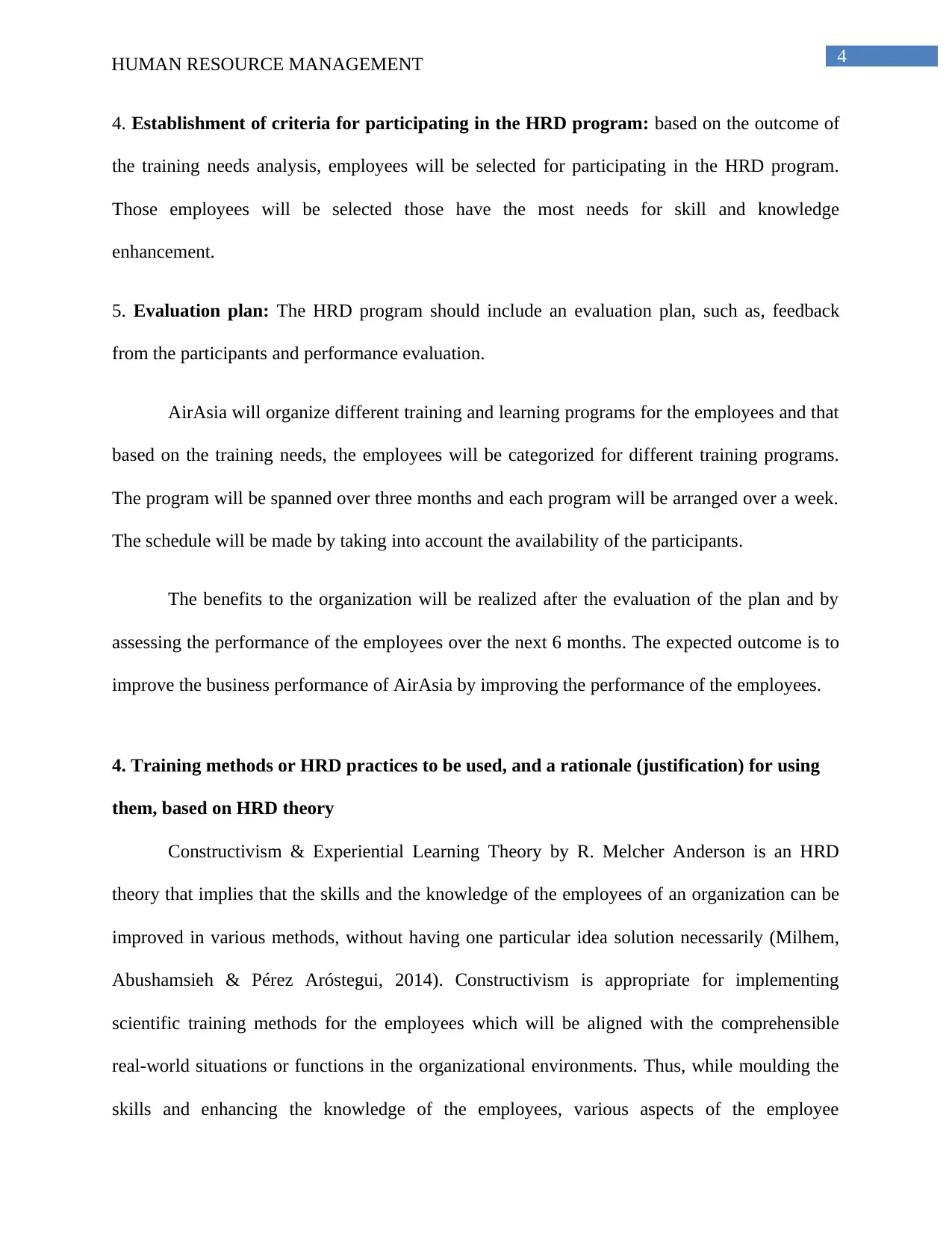
4HUMAN RESOURCE MANAGEMENT
4. Establishment of criteria for participating in the HRD program: based on the outcome of
the training needs analysis, employees will be selected for participating in the HRD program.
Those employees will be selected those have the most needs for skill and knowledge
enhancement.
5. Evaluation plan: The HRD program should include an evaluation plan, such as, feedback
from the participants and performance evaluation.
AirAsia will organize different training and learning programs for the employees and that
based on the training needs, the employees will be categorized for different training programs.
The program will be spanned over three months and each program will be arranged over a week.
The schedule will be made by taking into account the availability of the participants.
The benefits to the organization will be realized after the evaluation of the plan and by
assessing the performance of the employees over the next 6 months. The expected outcome is to
improve the business performance of AirAsia by improving the performance of the employees.
4. Training methods or HRD practices to be used, and a rationale (justification) for using
them, based on HRD theory
Constructivism & Experiential Learning Theory by R. Melcher Anderson is an HRD
theory that implies that the skills and the knowledge of the employees of an organization can be
improved in various methods, without having one particular idea solution necessarily (Milhem,
Abushamsieh & Pérez Aróstegui, 2014). Constructivism is appropriate for implementing
scientific training methods for the employees which will be aligned with the comprehensible
real-world situations or functions in the organizational environments. Thus, while moulding the
skills and enhancing the knowledge of the employees, various aspects of the employee
4. Establishment of criteria for participating in the HRD program: based on the outcome of
the training needs analysis, employees will be selected for participating in the HRD program.
Those employees will be selected those have the most needs for skill and knowledge
enhancement.
5. Evaluation plan: The HRD program should include an evaluation plan, such as, feedback
from the participants and performance evaluation.
AirAsia will organize different training and learning programs for the employees and that
based on the training needs, the employees will be categorized for different training programs.
The program will be spanned over three months and each program will be arranged over a week.
The schedule will be made by taking into account the availability of the participants.
The benefits to the organization will be realized after the evaluation of the plan and by
assessing the performance of the employees over the next 6 months. The expected outcome is to
improve the business performance of AirAsia by improving the performance of the employees.
4. Training methods or HRD practices to be used, and a rationale (justification) for using
them, based on HRD theory
Constructivism & Experiential Learning Theory by R. Melcher Anderson is an HRD
theory that implies that the skills and the knowledge of the employees of an organization can be
improved in various methods, without having one particular idea solution necessarily (Milhem,
Abushamsieh & Pérez Aróstegui, 2014). Constructivism is appropriate for implementing
scientific training methods for the employees which will be aligned with the comprehensible
real-world situations or functions in the organizational environments. Thus, while moulding the
skills and enhancing the knowledge of the employees, various aspects of the employee
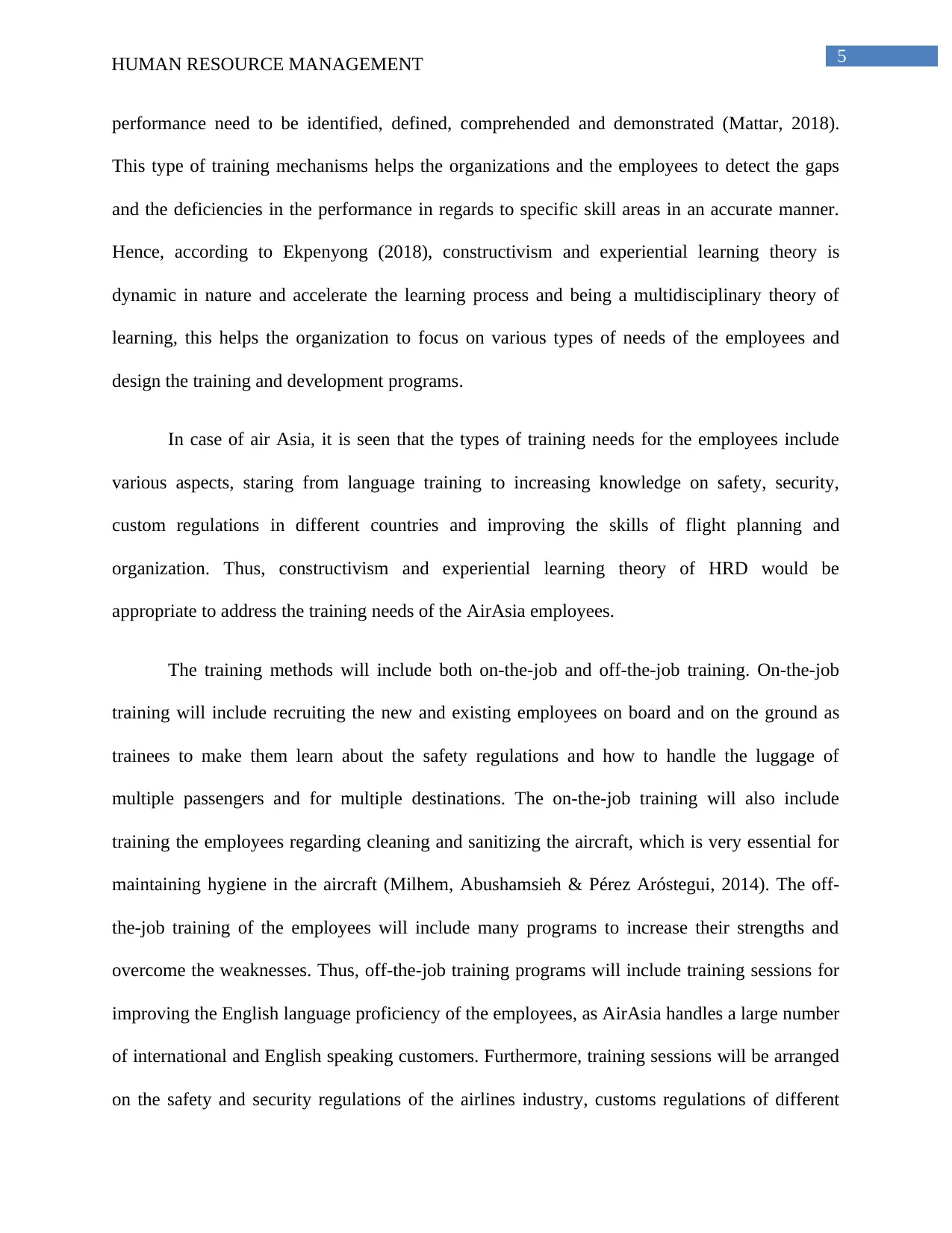
5HUMAN RESOURCE MANAGEMENT
performance need to be identified, defined, comprehended and demonstrated (Mattar, 2018).
This type of training mechanisms helps the organizations and the employees to detect the gaps
and the deficiencies in the performance in regards to specific skill areas in an accurate manner.
Hence, according to Ekpenyong (2018), constructivism and experiential learning theory is
dynamic in nature and accelerate the learning process and being a multidisciplinary theory of
learning, this helps the organization to focus on various types of needs of the employees and
design the training and development programs.
In case of air Asia, it is seen that the types of training needs for the employees include
various aspects, staring from language training to increasing knowledge on safety, security,
custom regulations in different countries and improving the skills of flight planning and
organization. Thus, constructivism and experiential learning theory of HRD would be
appropriate to address the training needs of the AirAsia employees.
The training methods will include both on-the-job and off-the-job training. On-the-job
training will include recruiting the new and existing employees on board and on the ground as
trainees to make them learn about the safety regulations and how to handle the luggage of
multiple passengers and for multiple destinations. The on-the-job training will also include
training the employees regarding cleaning and sanitizing the aircraft, which is very essential for
maintaining hygiene in the aircraft (Milhem, Abushamsieh & Pérez Aróstegui, 2014). The off-
the-job training of the employees will include many programs to increase their strengths and
overcome the weaknesses. Thus, off-the-job training programs will include training sessions for
improving the English language proficiency of the employees, as AirAsia handles a large number
of international and English speaking customers. Furthermore, training sessions will be arranged
on the safety and security regulations of the airlines industry, customs regulations of different
performance need to be identified, defined, comprehended and demonstrated (Mattar, 2018).
This type of training mechanisms helps the organizations and the employees to detect the gaps
and the deficiencies in the performance in regards to specific skill areas in an accurate manner.
Hence, according to Ekpenyong (2018), constructivism and experiential learning theory is
dynamic in nature and accelerate the learning process and being a multidisciplinary theory of
learning, this helps the organization to focus on various types of needs of the employees and
design the training and development programs.
In case of air Asia, it is seen that the types of training needs for the employees include
various aspects, staring from language training to increasing knowledge on safety, security,
custom regulations in different countries and improving the skills of flight planning and
organization. Thus, constructivism and experiential learning theory of HRD would be
appropriate to address the training needs of the AirAsia employees.
The training methods will include both on-the-job and off-the-job training. On-the-job
training will include recruiting the new and existing employees on board and on the ground as
trainees to make them learn about the safety regulations and how to handle the luggage of
multiple passengers and for multiple destinations. The on-the-job training will also include
training the employees regarding cleaning and sanitizing the aircraft, which is very essential for
maintaining hygiene in the aircraft (Milhem, Abushamsieh & Pérez Aróstegui, 2014). The off-
the-job training of the employees will include many programs to increase their strengths and
overcome the weaknesses. Thus, off-the-job training programs will include training sessions for
improving the English language proficiency of the employees, as AirAsia handles a large number
of international and English speaking customers. Furthermore, training sessions will be arranged
on the safety and security regulations of the airlines industry, customs regulations of different
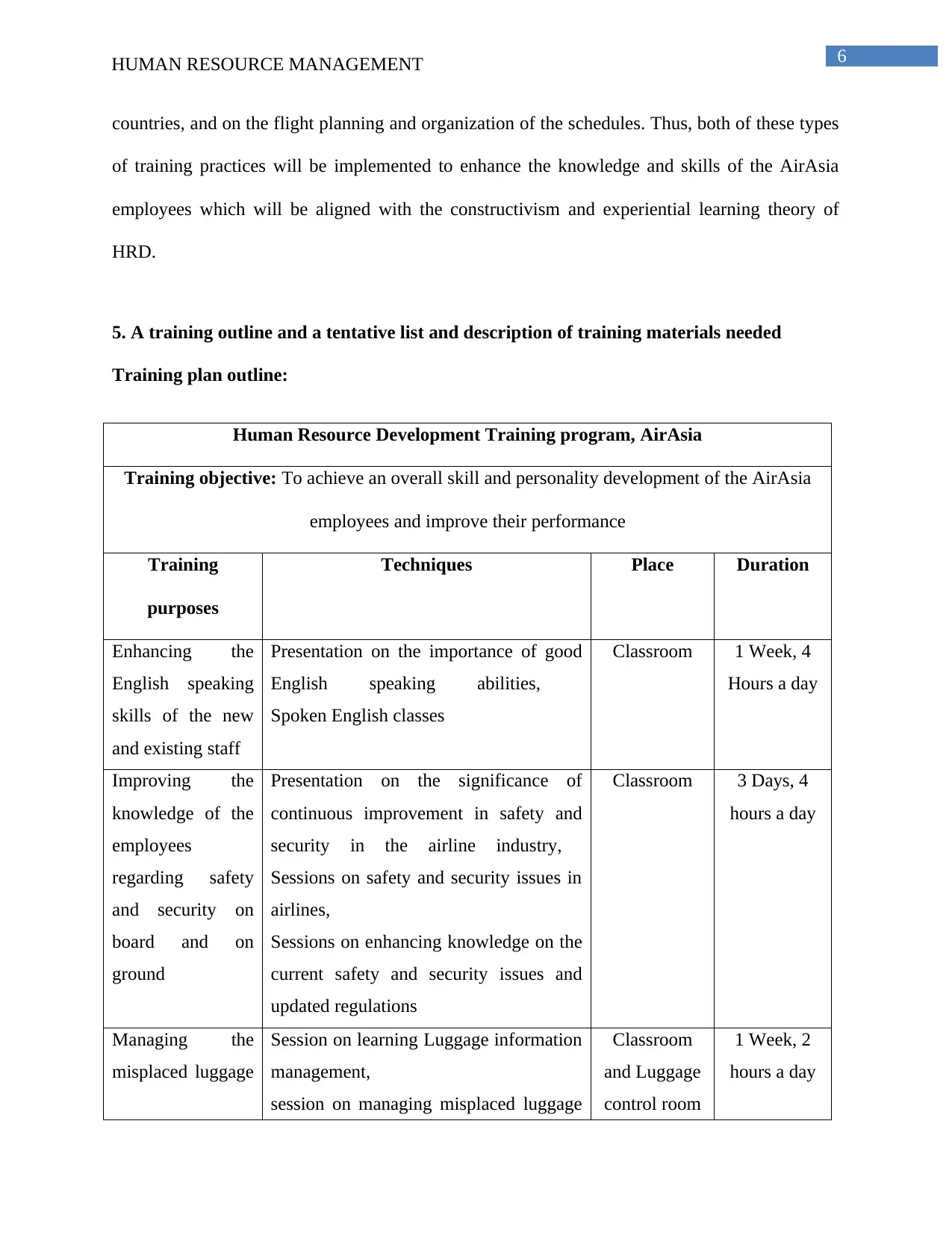
6HUMAN RESOURCE MANAGEMENT
countries, and on the flight planning and organization of the schedules. Thus, both of these types
of training practices will be implemented to enhance the knowledge and skills of the AirAsia
employees which will be aligned with the constructivism and experiential learning theory of
HRD.
5. A training outline and a tentative list and description of training materials needed
Training plan outline:
Human Resource Development Training program, AirAsia
Training objective: To achieve an overall skill and personality development of the AirAsia
employees and improve their performance
Training
purposes
Techniques Place Duration
Enhancing the
English speaking
skills of the new
and existing staff
Presentation on the importance of good
English speaking abilities,
Spoken English classes
Classroom 1 Week, 4
Hours a day
Improving the
knowledge of the
employees
regarding safety
and security on
board and on
ground
Presentation on the significance of
continuous improvement in safety and
security in the airline industry,
Sessions on safety and security issues in
airlines,
Sessions on enhancing knowledge on the
current safety and security issues and
updated regulations
Classroom 3 Days, 4
hours a day
Managing the
misplaced luggage
Session on learning Luggage information
management,
session on managing misplaced luggage
Classroom
and Luggage
control room
1 Week, 2
hours a day
countries, and on the flight planning and organization of the schedules. Thus, both of these types
of training practices will be implemented to enhance the knowledge and skills of the AirAsia
employees which will be aligned with the constructivism and experiential learning theory of
HRD.
5. A training outline and a tentative list and description of training materials needed
Training plan outline:
Human Resource Development Training program, AirAsia
Training objective: To achieve an overall skill and personality development of the AirAsia
employees and improve their performance
Training
purposes
Techniques Place Duration
Enhancing the
English speaking
skills of the new
and existing staff
Presentation on the importance of good
English speaking abilities,
Spoken English classes
Classroom 1 Week, 4
Hours a day
Improving the
knowledge of the
employees
regarding safety
and security on
board and on
ground
Presentation on the significance of
continuous improvement in safety and
security in the airline industry,
Sessions on safety and security issues in
airlines,
Sessions on enhancing knowledge on the
current safety and security issues and
updated regulations
Classroom 3 Days, 4
hours a day
Managing the
misplaced luggage
Session on learning Luggage information
management,
session on managing misplaced luggage
Classroom
and Luggage
control room
1 Week, 2
hours a day
Paraphrase This Document
Need a fresh take? Get an instant paraphrase of this document with our AI Paraphraser
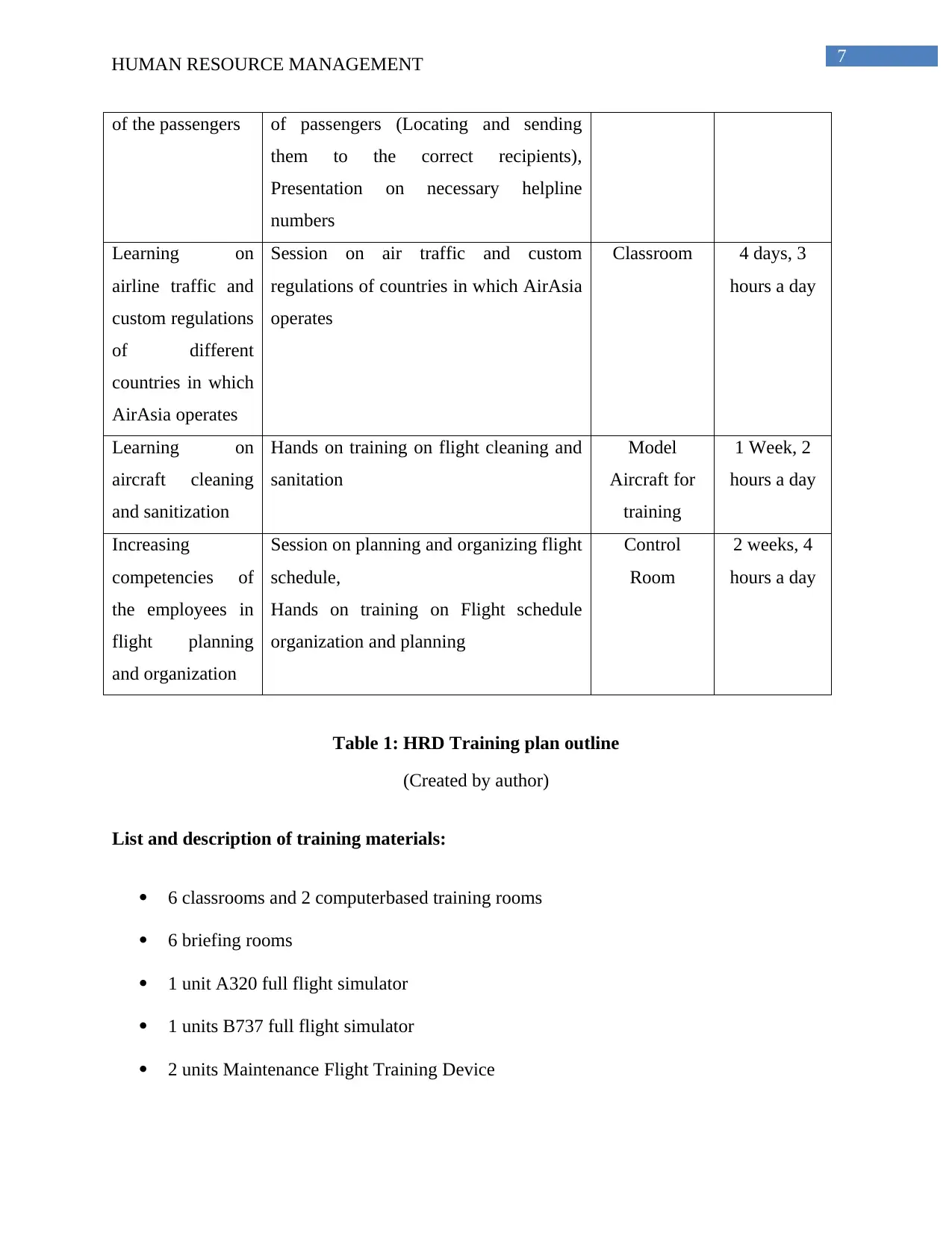
7HUMAN RESOURCE MANAGEMENT
of the passengers of passengers (Locating and sending
them to the correct recipients),
Presentation on necessary helpline
numbers
Learning on
airline traffic and
custom regulations
of different
countries in which
AirAsia operates
Session on air traffic and custom
regulations of countries in which AirAsia
operates
Classroom 4 days, 3
hours a day
Learning on
aircraft cleaning
and sanitization
Hands on training on flight cleaning and
sanitation
Model
Aircraft for
training
1 Week, 2
hours a day
Increasing
competencies of
the employees in
flight planning
and organization
Session on planning and organizing flight
schedule,
Hands on training on Flight schedule
organization and planning
Control
Room
2 weeks, 4
hours a day
Table 1: HRD Training plan outline
(Created by author)
List and description of training materials:
6 classrooms and 2 computerbased training rooms
6 briefing rooms
1 unit A320 full flight simulator
1 units B737 full flight simulator
2 units Maintenance Flight Training Device
of the passengers of passengers (Locating and sending
them to the correct recipients),
Presentation on necessary helpline
numbers
Learning on
airline traffic and
custom regulations
of different
countries in which
AirAsia operates
Session on air traffic and custom
regulations of countries in which AirAsia
operates
Classroom 4 days, 3
hours a day
Learning on
aircraft cleaning
and sanitization
Hands on training on flight cleaning and
sanitation
Model
Aircraft for
training
1 Week, 2
hours a day
Increasing
competencies of
the employees in
flight planning
and organization
Session on planning and organizing flight
schedule,
Hands on training on Flight schedule
organization and planning
Control
Room
2 weeks, 4
hours a day
Table 1: HRD Training plan outline
(Created by author)
List and description of training materials:
6 classrooms and 2 computerbased training rooms
6 briefing rooms
1 unit A320 full flight simulator
1 units B737 full flight simulator
2 units Maintenance Flight Training Device
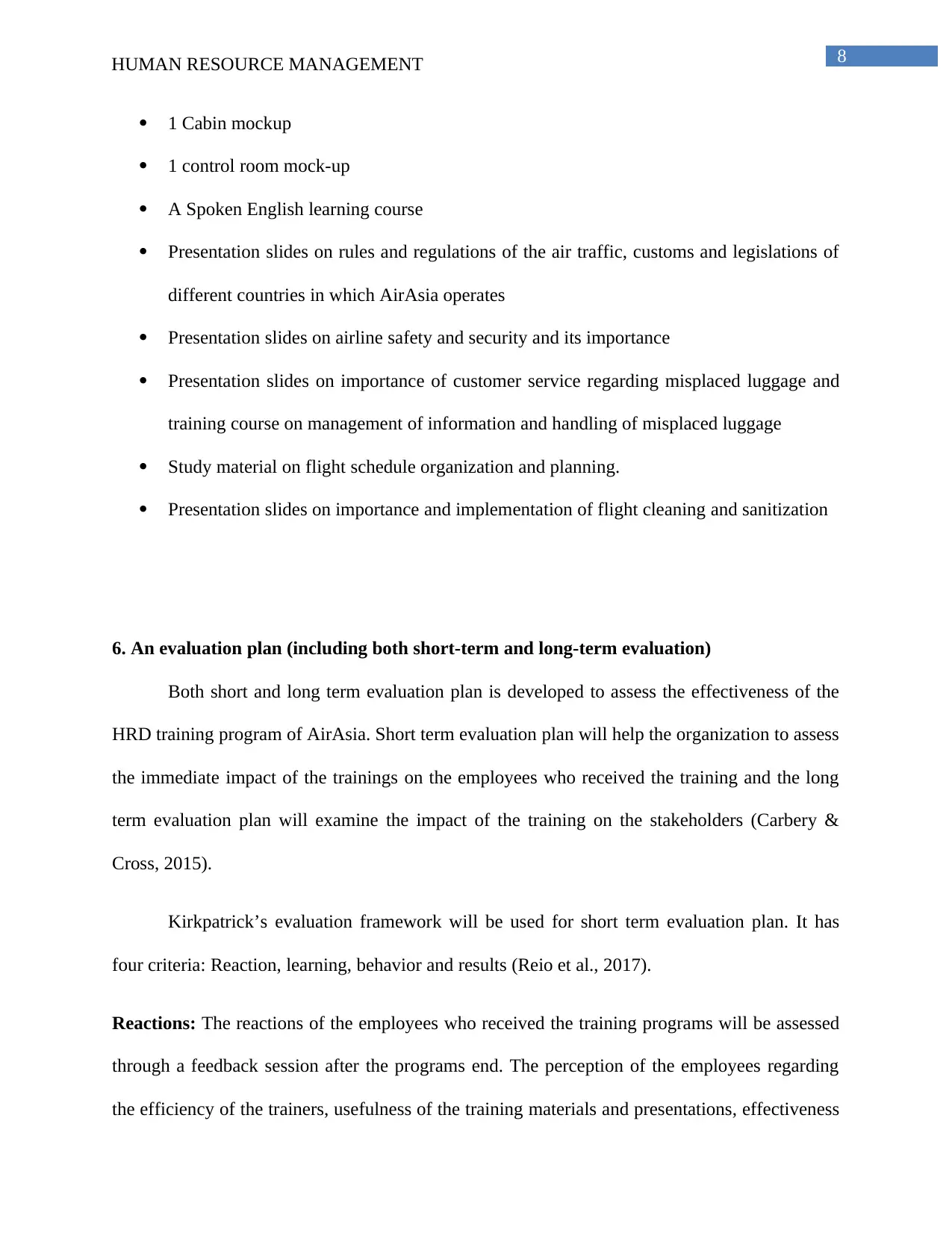
8HUMAN RESOURCE MANAGEMENT
1 Cabin mockup
1 control room mock-up
A Spoken English learning course
Presentation slides on rules and regulations of the air traffic, customs and legislations of
different countries in which AirAsia operates
Presentation slides on airline safety and security and its importance
Presentation slides on importance of customer service regarding misplaced luggage and
training course on management of information and handling of misplaced luggage
Study material on flight schedule organization and planning.
Presentation slides on importance and implementation of flight cleaning and sanitization
6. An evaluation plan (including both short-term and long-term evaluation)
Both short and long term evaluation plan is developed to assess the effectiveness of the
HRD training program of AirAsia. Short term evaluation plan will help the organization to assess
the immediate impact of the trainings on the employees who received the training and the long
term evaluation plan will examine the impact of the training on the stakeholders (Carbery &
Cross, 2015).
Kirkpatrick’s evaluation framework will be used for short term evaluation plan. It has
four criteria: Reaction, learning, behavior and results (Reio et al., 2017).
Reactions: The reactions of the employees who received the training programs will be assessed
through a feedback session after the programs end. The perception of the employees regarding
the efficiency of the trainers, usefulness of the training materials and presentations, effectiveness
1 Cabin mockup
1 control room mock-up
A Spoken English learning course
Presentation slides on rules and regulations of the air traffic, customs and legislations of
different countries in which AirAsia operates
Presentation slides on airline safety and security and its importance
Presentation slides on importance of customer service regarding misplaced luggage and
training course on management of information and handling of misplaced luggage
Study material on flight schedule organization and planning.
Presentation slides on importance and implementation of flight cleaning and sanitization
6. An evaluation plan (including both short-term and long-term evaluation)
Both short and long term evaluation plan is developed to assess the effectiveness of the
HRD training program of AirAsia. Short term evaluation plan will help the organization to assess
the immediate impact of the trainings on the employees who received the training and the long
term evaluation plan will examine the impact of the training on the stakeholders (Carbery &
Cross, 2015).
Kirkpatrick’s evaluation framework will be used for short term evaluation plan. It has
four criteria: Reaction, learning, behavior and results (Reio et al., 2017).
Reactions: The reactions of the employees who received the training programs will be assessed
through a feedback session after the programs end. The perception of the employees regarding
the efficiency of the trainers, usefulness of the training materials and presentations, effectiveness
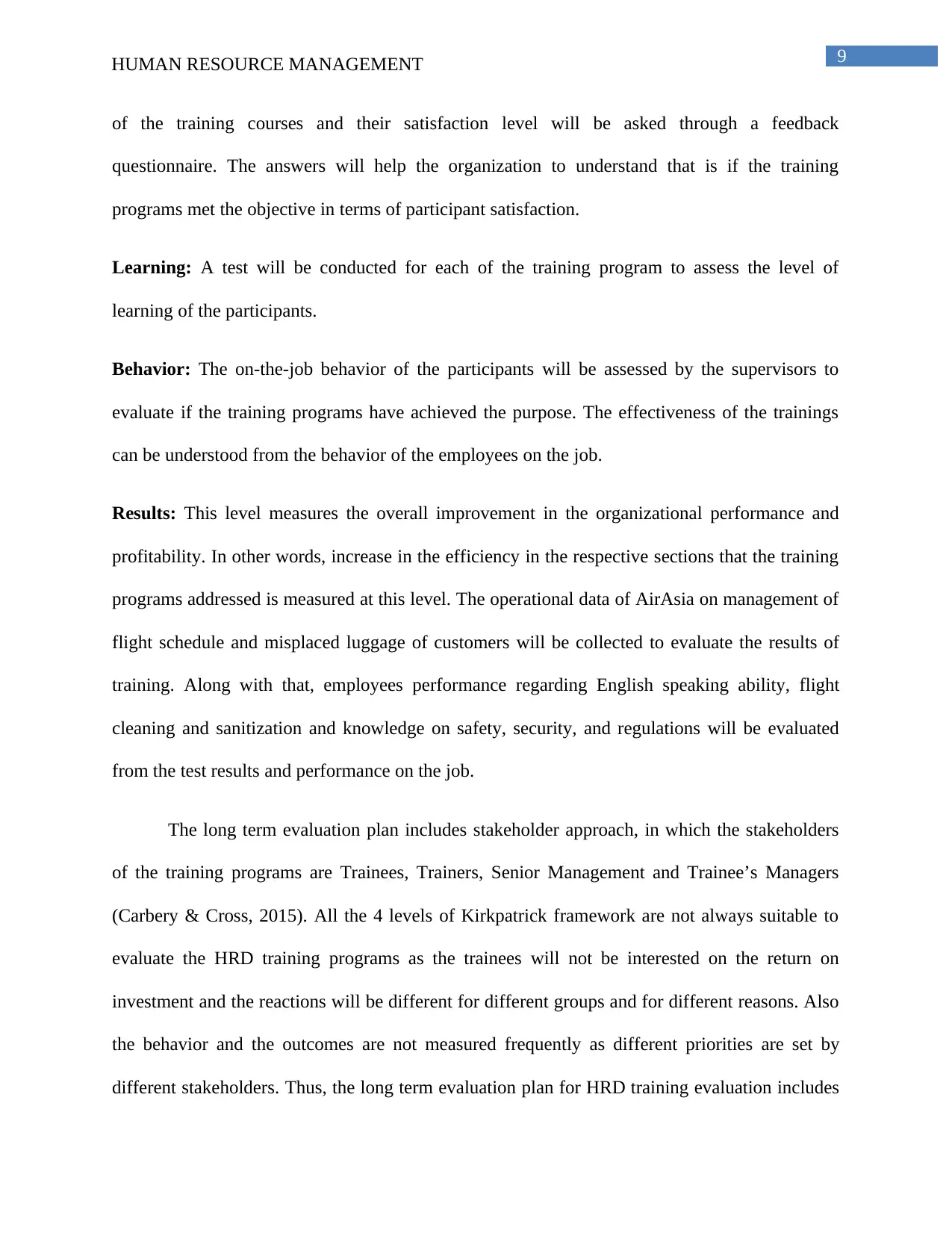
9HUMAN RESOURCE MANAGEMENT
of the training courses and their satisfaction level will be asked through a feedback
questionnaire. The answers will help the organization to understand that is if the training
programs met the objective in terms of participant satisfaction.
Learning: A test will be conducted for each of the training program to assess the level of
learning of the participants.
Behavior: The on-the-job behavior of the participants will be assessed by the supervisors to
evaluate if the training programs have achieved the purpose. The effectiveness of the trainings
can be understood from the behavior of the employees on the job.
Results: This level measures the overall improvement in the organizational performance and
profitability. In other words, increase in the efficiency in the respective sections that the training
programs addressed is measured at this level. The operational data of AirAsia on management of
flight schedule and misplaced luggage of customers will be collected to evaluate the results of
training. Along with that, employees performance regarding English speaking ability, flight
cleaning and sanitization and knowledge on safety, security, and regulations will be evaluated
from the test results and performance on the job.
The long term evaluation plan includes stakeholder approach, in which the stakeholders
of the training programs are Trainees, Trainers, Senior Management and Trainee’s Managers
(Carbery & Cross, 2015). All the 4 levels of Kirkpatrick framework are not always suitable to
evaluate the HRD training programs as the trainees will not be interested on the return on
investment and the reactions will be different for different groups and for different reasons. Also
the behavior and the outcomes are not measured frequently as different priorities are set by
different stakeholders. Thus, the long term evaluation plan for HRD training evaluation includes
of the training courses and their satisfaction level will be asked through a feedback
questionnaire. The answers will help the organization to understand that is if the training
programs met the objective in terms of participant satisfaction.
Learning: A test will be conducted for each of the training program to assess the level of
learning of the participants.
Behavior: The on-the-job behavior of the participants will be assessed by the supervisors to
evaluate if the training programs have achieved the purpose. The effectiveness of the trainings
can be understood from the behavior of the employees on the job.
Results: This level measures the overall improvement in the organizational performance and
profitability. In other words, increase in the efficiency in the respective sections that the training
programs addressed is measured at this level. The operational data of AirAsia on management of
flight schedule and misplaced luggage of customers will be collected to evaluate the results of
training. Along with that, employees performance regarding English speaking ability, flight
cleaning and sanitization and knowledge on safety, security, and regulations will be evaluated
from the test results and performance on the job.
The long term evaluation plan includes stakeholder approach, in which the stakeholders
of the training programs are Trainees, Trainers, Senior Management and Trainee’s Managers
(Carbery & Cross, 2015). All the 4 levels of Kirkpatrick framework are not always suitable to
evaluate the HRD training programs as the trainees will not be interested on the return on
investment and the reactions will be different for different groups and for different reasons. Also
the behavior and the outcomes are not measured frequently as different priorities are set by
different stakeholders. Thus, the long term evaluation plan for HRD training evaluation includes
Secure Best Marks with AI Grader
Need help grading? Try our AI Grader for instant feedback on your assignments.
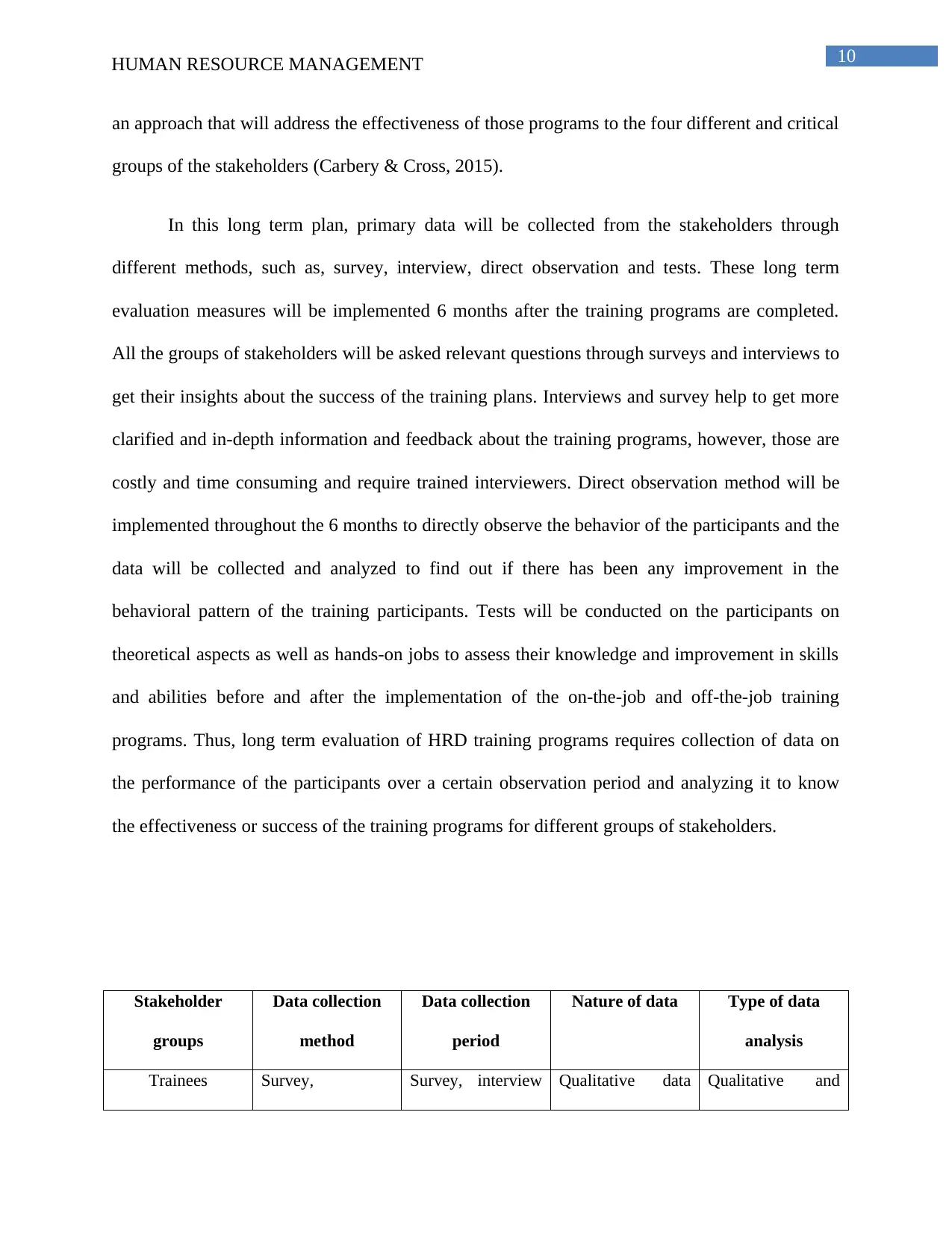
10HUMAN RESOURCE MANAGEMENT
an approach that will address the effectiveness of those programs to the four different and critical
groups of the stakeholders (Carbery & Cross, 2015).
In this long term plan, primary data will be collected from the stakeholders through
different methods, such as, survey, interview, direct observation and tests. These long term
evaluation measures will be implemented 6 months after the training programs are completed.
All the groups of stakeholders will be asked relevant questions through surveys and interviews to
get their insights about the success of the training plans. Interviews and survey help to get more
clarified and in-depth information and feedback about the training programs, however, those are
costly and time consuming and require trained interviewers. Direct observation method will be
implemented throughout the 6 months to directly observe the behavior of the participants and the
data will be collected and analyzed to find out if there has been any improvement in the
behavioral pattern of the training participants. Tests will be conducted on the participants on
theoretical aspects as well as hands-on jobs to assess their knowledge and improvement in skills
and abilities before and after the implementation of the on-the-job and off-the-job training
programs. Thus, long term evaluation of HRD training programs requires collection of data on
the performance of the participants over a certain observation period and analyzing it to know
the effectiveness or success of the training programs for different groups of stakeholders.
Stakeholder
groups
Data collection
method
Data collection
period
Nature of data Type of data
analysis
Trainees Survey, Survey, interview Qualitative data Qualitative and
an approach that will address the effectiveness of those programs to the four different and critical
groups of the stakeholders (Carbery & Cross, 2015).
In this long term plan, primary data will be collected from the stakeholders through
different methods, such as, survey, interview, direct observation and tests. These long term
evaluation measures will be implemented 6 months after the training programs are completed.
All the groups of stakeholders will be asked relevant questions through surveys and interviews to
get their insights about the success of the training plans. Interviews and survey help to get more
clarified and in-depth information and feedback about the training programs, however, those are
costly and time consuming and require trained interviewers. Direct observation method will be
implemented throughout the 6 months to directly observe the behavior of the participants and the
data will be collected and analyzed to find out if there has been any improvement in the
behavioral pattern of the training participants. Tests will be conducted on the participants on
theoretical aspects as well as hands-on jobs to assess their knowledge and improvement in skills
and abilities before and after the implementation of the on-the-job and off-the-job training
programs. Thus, long term evaluation of HRD training programs requires collection of data on
the performance of the participants over a certain observation period and analyzing it to know
the effectiveness or success of the training programs for different groups of stakeholders.
Stakeholder
groups
Data collection
method
Data collection
period
Nature of data Type of data
analysis
Trainees Survey, Survey, interview Qualitative data Qualitative and
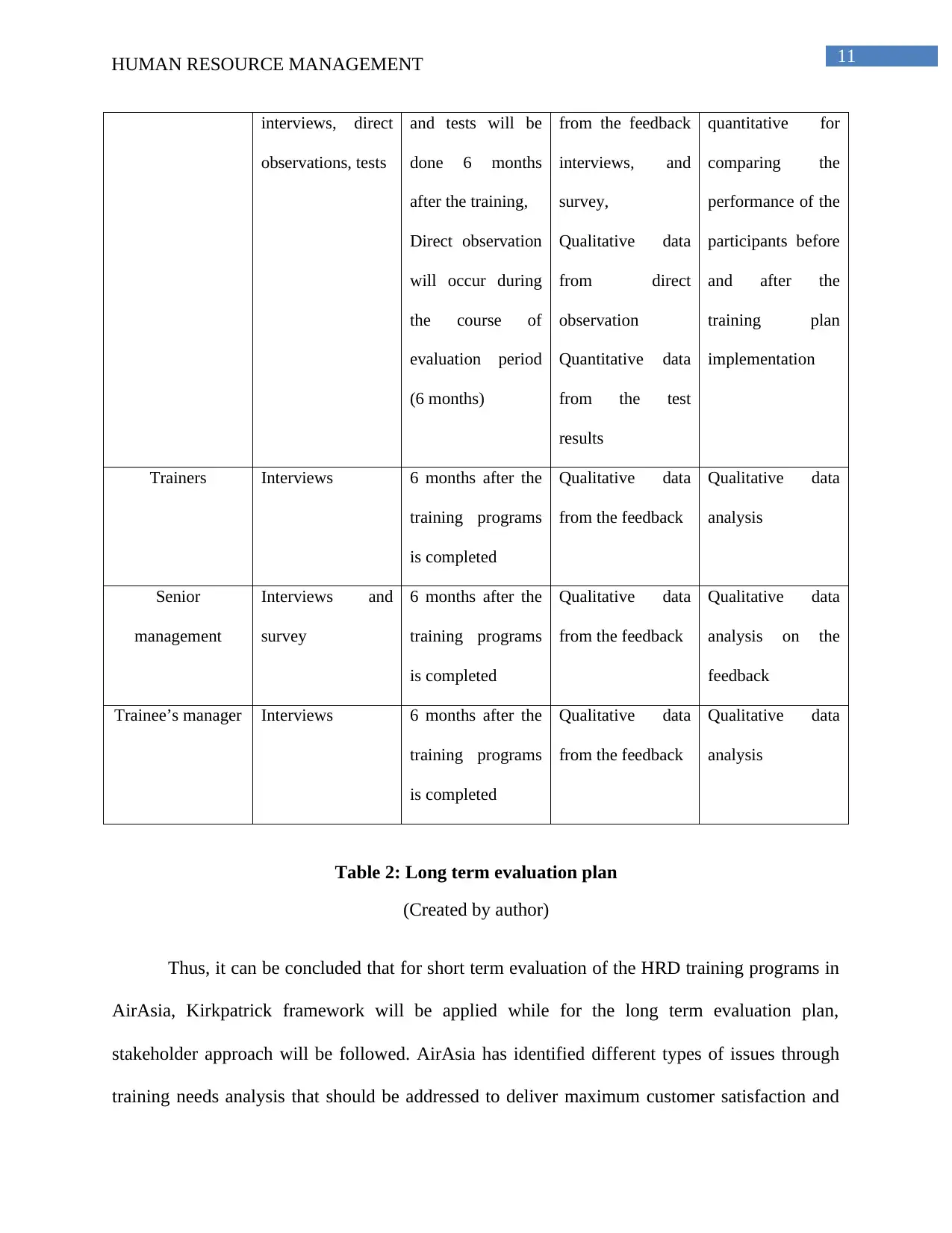
11HUMAN RESOURCE MANAGEMENT
interviews, direct
observations, tests
and tests will be
done 6 months
after the training,
Direct observation
will occur during
the course of
evaluation period
(6 months)
from the feedback
interviews, and
survey,
Qualitative data
from direct
observation
Quantitative data
from the test
results
quantitative for
comparing the
performance of the
participants before
and after the
training plan
implementation
Trainers Interviews 6 months after the
training programs
is completed
Qualitative data
from the feedback
Qualitative data
analysis
Senior
management
Interviews and
survey
6 months after the
training programs
is completed
Qualitative data
from the feedback
Qualitative data
analysis on the
feedback
Trainee’s manager Interviews 6 months after the
training programs
is completed
Qualitative data
from the feedback
Qualitative data
analysis
Table 2: Long term evaluation plan
(Created by author)
Thus, it can be concluded that for short term evaluation of the HRD training programs in
AirAsia, Kirkpatrick framework will be applied while for the long term evaluation plan,
stakeholder approach will be followed. AirAsia has identified different types of issues through
training needs analysis that should be addressed to deliver maximum customer satisfaction and
interviews, direct
observations, tests
and tests will be
done 6 months
after the training,
Direct observation
will occur during
the course of
evaluation period
(6 months)
from the feedback
interviews, and
survey,
Qualitative data
from direct
observation
Quantitative data
from the test
results
quantitative for
comparing the
performance of the
participants before
and after the
training plan
implementation
Trainers Interviews 6 months after the
training programs
is completed
Qualitative data
from the feedback
Qualitative data
analysis
Senior
management
Interviews and
survey
6 months after the
training programs
is completed
Qualitative data
from the feedback
Qualitative data
analysis on the
feedback
Trainee’s manager Interviews 6 months after the
training programs
is completed
Qualitative data
from the feedback
Qualitative data
analysis
Table 2: Long term evaluation plan
(Created by author)
Thus, it can be concluded that for short term evaluation of the HRD training programs in
AirAsia, Kirkpatrick framework will be applied while for the long term evaluation plan,
stakeholder approach will be followed. AirAsia has identified different types of issues through
training needs analysis that should be addressed to deliver maximum customer satisfaction and
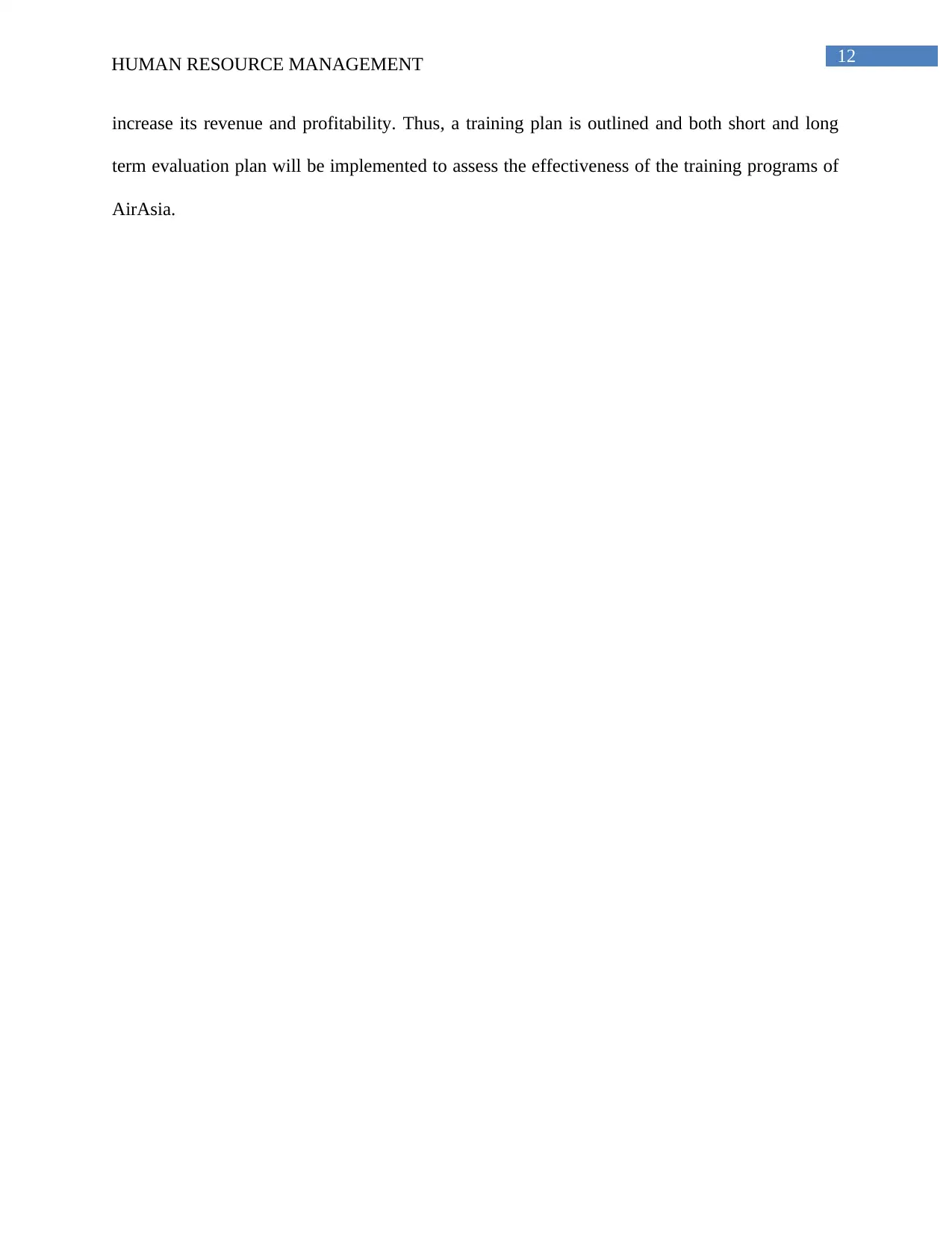
12HUMAN RESOURCE MANAGEMENT
increase its revenue and profitability. Thus, a training plan is outlined and both short and long
term evaluation plan will be implemented to assess the effectiveness of the training programs of
AirAsia.
increase its revenue and profitability. Thus, a training plan is outlined and both short and long
term evaluation plan will be implemented to assess the effectiveness of the training programs of
AirAsia.
Paraphrase This Document
Need a fresh take? Get an instant paraphrase of this document with our AI Paraphraser
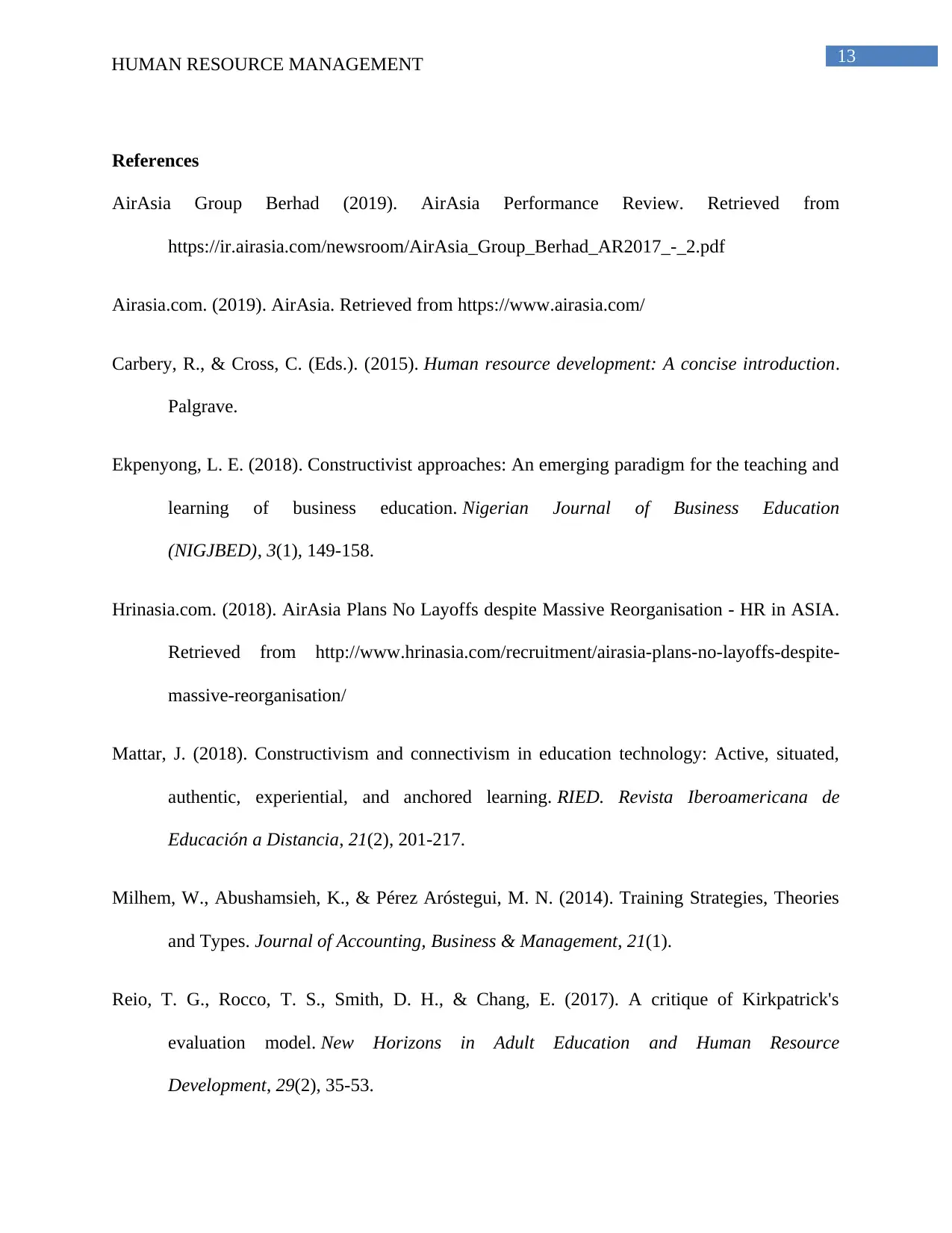
13HUMAN RESOURCE MANAGEMENT
References
AirAsia Group Berhad (2019). AirAsia Performance Review. Retrieved from
https://ir.airasia.com/newsroom/AirAsia_Group_Berhad_AR2017_-_2.pdf
Airasia.com. (2019). AirAsia. Retrieved from https://www.airasia.com/
Carbery, R., & Cross, C. (Eds.). (2015). Human resource development: A concise introduction.
Palgrave.
Ekpenyong, L. E. (2018). Constructivist approaches: An emerging paradigm for the teaching and
learning of business education. Nigerian Journal of Business Education
(NIGJBED), 3(1), 149-158.
Hrinasia.com. (2018). AirAsia Plans No Layoffs despite Massive Reorganisation - HR in ASIA.
Retrieved from http://www.hrinasia.com/recruitment/airasia-plans-no-layoffs-despite-
massive-reorganisation/
Mattar, J. (2018). Constructivism and connectivism in education technology: Active, situated,
authentic, experiential, and anchored learning. RIED. Revista Iberoamericana de
Educación a Distancia, 21(2), 201-217.
Milhem, W., Abushamsieh, K., & Pérez Aróstegui, M. N. (2014). Training Strategies, Theories
and Types. Journal of Accounting, Business & Management, 21(1).
Reio, T. G., Rocco, T. S., Smith, D. H., & Chang, E. (2017). A critique of Kirkpatrick's
evaluation model. New Horizons in Adult Education and Human Resource
Development, 29(2), 35-53.
References
AirAsia Group Berhad (2019). AirAsia Performance Review. Retrieved from
https://ir.airasia.com/newsroom/AirAsia_Group_Berhad_AR2017_-_2.pdf
Airasia.com. (2019). AirAsia. Retrieved from https://www.airasia.com/
Carbery, R., & Cross, C. (Eds.). (2015). Human resource development: A concise introduction.
Palgrave.
Ekpenyong, L. E. (2018). Constructivist approaches: An emerging paradigm for the teaching and
learning of business education. Nigerian Journal of Business Education
(NIGJBED), 3(1), 149-158.
Hrinasia.com. (2018). AirAsia Plans No Layoffs despite Massive Reorganisation - HR in ASIA.
Retrieved from http://www.hrinasia.com/recruitment/airasia-plans-no-layoffs-despite-
massive-reorganisation/
Mattar, J. (2018). Constructivism and connectivism in education technology: Active, situated,
authentic, experiential, and anchored learning. RIED. Revista Iberoamericana de
Educación a Distancia, 21(2), 201-217.
Milhem, W., Abushamsieh, K., & Pérez Aróstegui, M. N. (2014). Training Strategies, Theories
and Types. Journal of Accounting, Business & Management, 21(1).
Reio, T. G., Rocco, T. S., Smith, D. H., & Chang, E. (2017). A critique of Kirkpatrick's
evaluation model. New Horizons in Adult Education and Human Resource
Development, 29(2), 35-53.

14HUMAN RESOURCE MANAGEMENT
1 out of 15
Your All-in-One AI-Powered Toolkit for Academic Success.
+13062052269
info@desklib.com
Available 24*7 on WhatsApp / Email
![[object Object]](/_next/static/media/star-bottom.7253800d.svg)
Unlock your academic potential
© 2024 | Zucol Services PVT LTD | All rights reserved.





